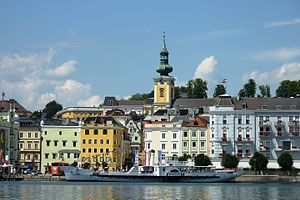Gmunden
| Gmunden | ||
|---|---|---|

Lakeside
|
||
|
||
| Location within Austria | ||
| Coordinates: 47°55′05″N 13°47′58″E / 47.91806°N 13.79944°ECoordinates: 47°55′05″N 13°47′58″E / 47.91806°N 13.79944°E | ||
| Country | Austria | |
| State | Upper Austria | |
| District | Gmunden | |
| Government | ||
| • Mayor | Stefan Krapf (ÖVP) | |
| Area | ||
| • Total | 63.55 km2 (24.54 sq mi) | |
| Elevation | 425 m (1,394 ft) | |
| Population (14 June 2016) | ||
| • Total | 13,204 | |
| • Density | 210/km2 (540/sq mi) | |
| Time zone | CET (UTC+1) | |
| • Summer (DST) | CEST (UTC+2) | |
| Postal code | 4810 | |
| Area code | 07612 | |
| Vehicle registration | GM | |
| Website | www.gmunden.ooe.gv.at | |
Gmunden ([ˈɡmʊndən]) is a town in Upper Austria, Austria in the district of Gmunden. It has 13,204 inhabitants (estimates 2016 ). It is much frequented as a health and summer resort, and has a variety of lake, brine, vegetable and pine-cone baths, a hydropathic establishment, inhalation chambers, whey cure, etc. It is also an important centre of the salt industry in Salzkammergut.
Gmunden covers an area of 63.49 square kilometres (24.51 sq mi) and has a median height of 425 metres (1,394 ft). It is situated next to the lake Traunsee on the Traun River and is surrounded by high mountains, including the Traunstein (mountain) (5,446 feet or 1,660 metres), the Erlakogel (5150 ft), the Wilder Kogel (6,860 feet or 2,090 metres) and the Höllengebirge.
Gmunden is divided into the following boroughs: Gmunden, Gmunden-Ort, Schlagen, Traundorf, Unterm Stein.
As of 2001, Gmunden had a population of 13,336. Of that, 88.4% were Austrian in nationality, 1.5% are from other European Union states, and 10.2% are other foreigners. Citizens of Bosnia-Herzegovina (3.6%) and the former Federal Republic of Yugoslavia (2.7%) placed the strongest foreigner portion, followed by Turks (1.2%) and Germans (1.1%).
The majority (69.3%) confess themselves to the Roman Catholic Church. Evangelicals are next, which 7.3% of the population associate with. 5.9% are Muslims and 3.3% are Orthodox. 10.3% are nonreligious.
A settlement was in existence already in the fifth century AC. By 1186 Gmunden was a fortified place surrounded by walls, although it did not receive a church until about 1300. In 1278 Gmunden became a town. On November 14, 1626 an army of rebellious peasants was completely defeated at Gmunden by General Pappenheim, who had been ordered by Maximilian I to suppress the peasant rebellion in Upper Austria. The dead peasant insurgents were buried in nearby Pinsdorf, where an obelisk styled memorial known as the Bauernhügel in their honour can still be seen.
...
Wikipedia


